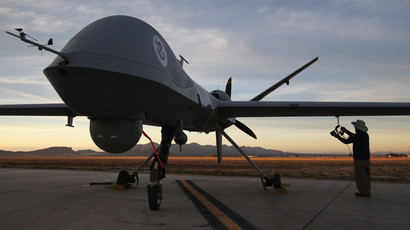Navy’s ocean-powered drones to wage underwater war

While American drones patrol the skies in war-torn countries like Afghanistan, the United States is also looking to establish a similar presence in the world’s oceans – by using underwater drones.
The new ocean-faring drones, called “Slocum Gliders,” won’t need fuel to function like their aerial counterparts do. Instead, they’ll power themselves with the ocean current itself, stealthily scanning the surrounding area and feeding information back to other military vessels.
Using a process dubbed “hydraulic buoyancy,” the Glider can adjust its density based on the water around it. This allows the drone to sink lower or raise itself up among the ocean currents, moving at a speed of up to one mile (1.6 km) an hour.
According to a report by Time, the Navy is currently planning to send one of these gliders on a five-year test run. The drones are named after Captain Joshua Slocum, who became the first man to single-handedly sail around the entire world in the late 1800s.
Currently, the gliders gather data related to the surrounding water, which can be used to effectively calibrate sonar. A new $203,000 contract with Teledyne Webb Research, however, has the potential to add more capabilities to the machines. Eventually, the Navy hopes that a group of gliders will be able to detect underwater mines and enemy submarines in the event of war.
“Carrying a wide variety of sensors, they can be programmed to patrol for weeks at a time, surfacing to transmit their data to shore while downloading new instructions at regular intervals, realizing a substantial cost savings compared to traditional surface ships,” reads the Slocum Glider page on Teledyne’s website.
The gliders were first commissioned by the Navy in 2009, when it invested just over $56 million for up to 150 “Littoral Battleship-Sensing” gliders. These are scheduled to arrive in 2014, and according to Time, the Navy is hoping they will be used “for mine countermeasures and other tasks important to expeditionary warfare...ultimately reducing or eliminating the need for sailors and Marines to enter the dangerous shallow waters just off shore in order to clear mines in preparation for expeditionary operations.”
Meanwhile, a NATO report from last year explored the possibility that gliders could be launched directly from submarines instead of surface ships.
“Operating gliders from submarines represents a step forward to embedding this technology into naval operations,” the report said. “Unlike surface ships, submarines are stealth platforms that could transit denied areas while releasing a glider fleet,” the report stated.
Even as the US expands its surveillance capabilities under the sea, it is also using the ocean to boost its fleet of airborne drones. Earlier this month, RT reported that the Navy successfully launched an aerial drone into the sky from a submerged submarine.














